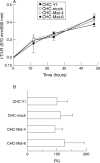Contribution of matrilysin (MMP-7) to the metastatic pathway of human colorectal cancers
- PMID: 10403738
- PMCID: PMC1727600
- DOI: 10.1136/gut.45.2.252
Contribution of matrilysin (MMP-7) to the metastatic pathway of human colorectal cancers
Abstract
Background/aim: Matrilysin is one of the matrix metalloproteinases that has a critical role in tumour invasion, and is often expressed in gastrointestinal cancers. The aim of this study was to examine the role of matrilysin in metastasis of human colorectal cancers. PATIENTS (SUBJECTS)/METHODS: The relation between matrilysin expression and Dukes's type was investigated immunohistochemically in 83 surgically resected colorectal cancers, including five with liver metastasis. Moreover, the effects of matrilysin on the in vivo invasive and metastatic potential of colon cancer cells transfected with matrilysin cDNA were examined after subcutaneous injection into SCID mice.
Results: In 46% of primary and all of metastatic liver tumours, over 10% of cancer cells were stained positively for matrilysin. The expression of matrilysin correlated significantly with the presence of nodal or distant metastases (p<0.05). In addition, matrilysin transfectants formed invasive tumours and multiple liver metastases in SCID mice, without producing any significant difference in the subcutaneous tumour growth from mock transfectants. Casein zymography showed that the invading and metastasised tumours showed conspicuous matrilysin activity, which correlated with the number of metastatic lesions (p<0.001).
Conclusions: Matrilysin showed a correlation with metastasis in a cohort of 83 colorectal cancer patients and marked metastatic potentiation in human colorectal cancer xenografts, indicating that it may play a critical role in the metastatic pathway of colorectal cancers.
Figures






References
Publication types
MeSH terms
Substances
LinkOut - more resources
Full Text Sources
Other Literature Sources
Medical
